History
THE LOS ANGELES RHODESLI SEPHARDIC COMMUNITY
(Encompassing the Sociedad Pas y Progresso, the Sephardic Hebrew Center, the Sephardic Beth Shalom and its merger with Sephardic Temple Tifereth Israel)
By Aron Hasson
In 1900, the Sephardic Jewish quarter of Rhodes[1], called “La Juderia“, had a population of approximately 4,000 people. Historians have recorded that Jews lived on the Island of Rhodes since ancient times, although the social-cultural background of “La Juderia” at the beginning of this century was derived primarily from the large number of Jews who settled there after “The Spanish Inquisition of 1492”. Despite living on the Island of Rhodes alongside Turkish and Greek populations for four centuries, the Jews continued to speak their native language from Spain, called “Ladino” or “Judeo-Spanish“.
The Island offered limited economic possibilities, and this caused young men to seek better opportunities elsewhere, some in nearby ports of the Mediterranean, while others traveled to far off places in Africa, as well as in North and South America.[2] Most of the young men who traveled to other lands initially went with the intention of making some money and then returning to pursue their family life on the Island.
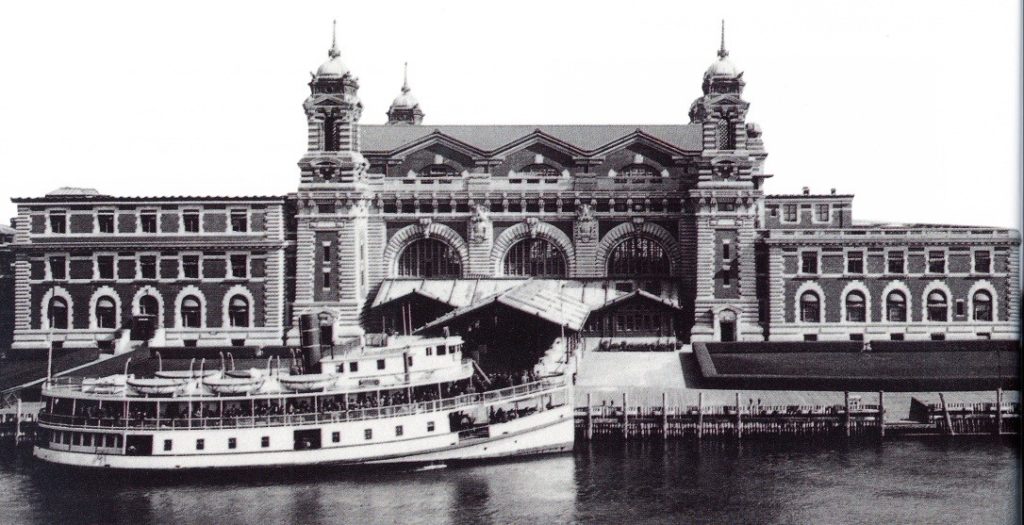
Ellis Island
The first young Rhodesli Sephardic men coming to the United States traveled by ship to Ellis Island in New York. They settled in sections populated by Ashkenazic Jews, such as the Rivington Street area, although there was limited contact between the communities. The fact that Judaism united them was outweighed by the fact that Ladino and Yiddish separated them. Some traveled by train to cities in the South and the West Coast. The first Rhodeslis on the West Coast established themselves in Seattle, Washington, where a few pioneers had gone ahead and sent back reports of prosperity there. A few of the Rhodeslis proceeded by train to Portland, Oregon and even more traveled south to Los Angeles.
Due to their inability to speak English, most of the young men who arrived in Los Angeles would take “immigrant” jobs, such as selling flowers, fruit or shining shoes. A significant portion of their earnings was sent back to the Island of Rhodes to help support their families. This in turn encouraged others to travel to Los Angeles to improve their own living situations.
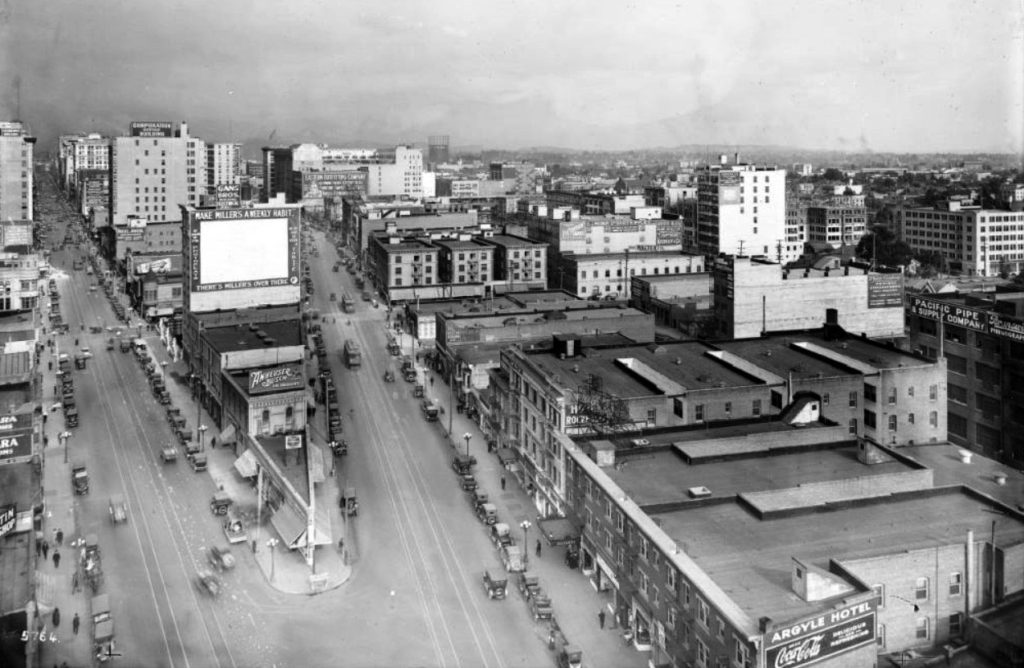
1917 Downtown Los Angeles: Intersection of Main, Spring and 9th streets.
Many of the first pioneers, being single men or married men, were working in order to raise money and reunite with their families. Although, for some there was a desire to reunify with their families in Los Angeles, their was also a reluctance of the new immigrants to sever themselves from their roots in Rhodes. If the economic conditions on the Island would have been better they would have stayed there. In fact, some of the men did return to Rhodes and tried to set up a business, but often times it did not last and then they would decide to return to the United States to earn more money again.
The young Rhodesli men lived in downtown Los Angeles within a few blocks of each other (primarily between Main Street and Central Avenue and 3rd and 9th Streets). They settled among a number of Sephardim who came from other Aegean Sea communities. As their numbers increased, it became evident that an organization was needed to take care of religious and social needs.
In September of 1912, after preliminary meetings, the first Sephardic organization of Los Angeles was formed and called itself the “Sociedad Ahavat Shalom” (“Love of Peace Society”), and it met primarily for religious services and caring for the sick.[3] Approximately half of these first Los Angeles Sephardim were from the Island of Rhodes. This organization lasted only a short time before it dissolved. It had split into four groups of people primarily corresponding to regional Aegean Sea origins and cultural differences.[4]
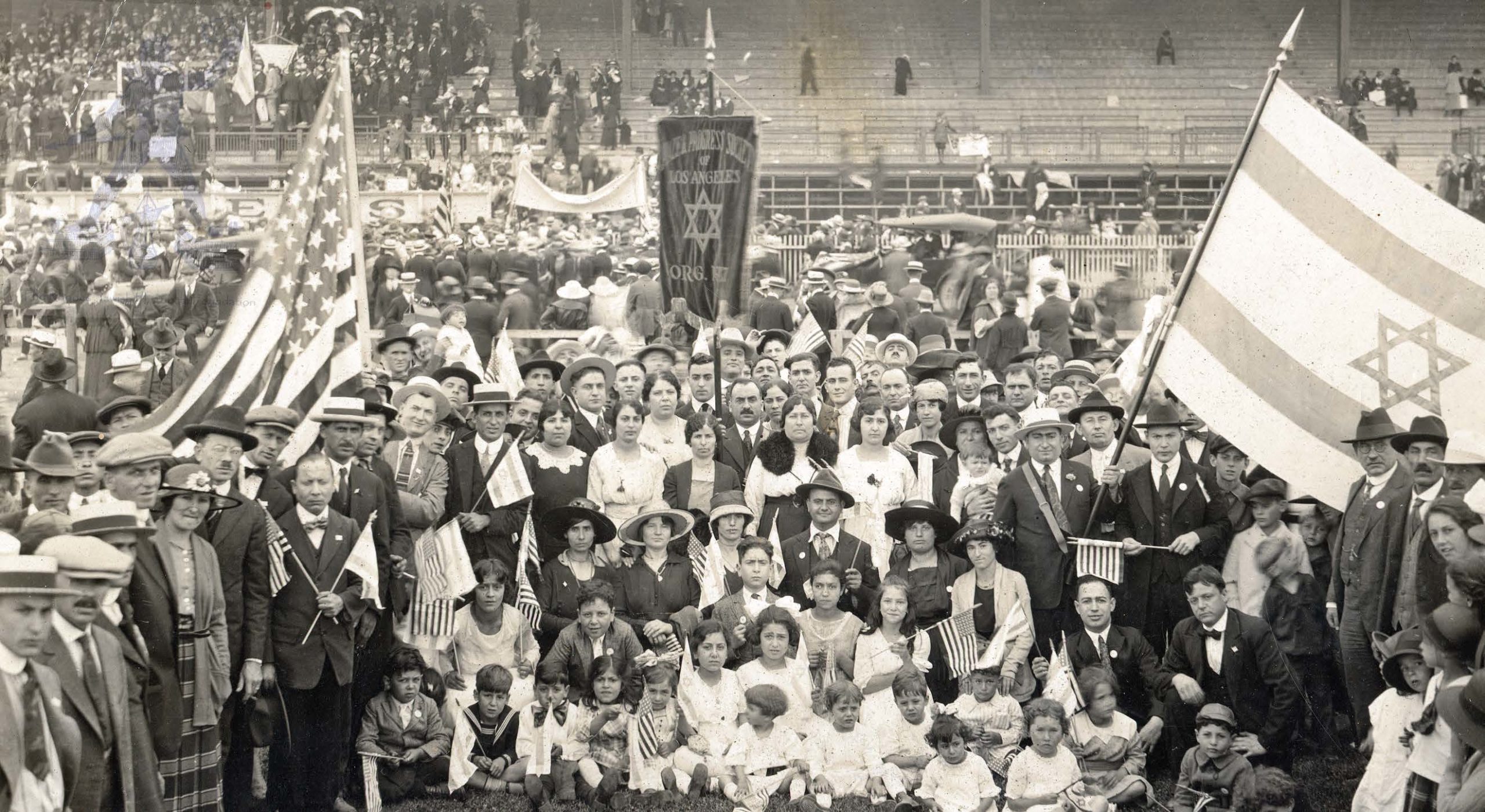
Peace and Progress Society
At a meeting held on February 5, 1917, at a downtown Los Angeles Sephardic restaurant, immigrants from the Island of Rhodes founded the “Sociedad Pas y Progresso”[5] (“Peace and Progress Society”), which functioned as a congregation or synagogue. This 1917 meeting was attended by approximately 45 young men and an election was held which selected the ten founding officers for this synagogue. They were: Morris Soriano (president), Jack Notrica (vice-president), Joseph Hasson (treasurer), Joseph Mayo (secretary), Louis Israel (assistant secretary), Marco Tarica (collector) and Victor Levy, Louis Benveniste, Abraham Hazan and Reuben Israel (trustees).[6] This small downtown Sephardic restaurant was located at the corner of 4th and Wall Streets. The restaurant prepared the traditional Sephardic foods, and served as an important meeting place for the new immigrants who lived in nearby boarding houses.[7]
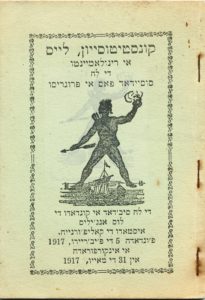
1917 Peace and Progress Society Constitution Cover
The primary functions of the Peace and Progress Society were to conduct religious services and to help those among themselves in need, as well as with the Sephardic communities overseas. These goals were stated in the Articles of Incorporation of the Peace and Progress Society, registered with the State of California on May 18, 1917:
“That the purposes for which this corporation is organized are: the aid, comfort, and moral and financial assistance of Jewish men, women and children of Turkish origin[8] or descent; to educate, uplift and ameliorate the conditions of poor or uneducated Jewish men, women and children of Turkish origin or descent; to care for sick members, and to bury the dead; to promote friendship and good will; to perform any and all acts of a charitable nature; to own and construct buildings for all the purposes of the corporation; and, to accumulate funds for the purpose of carrying out the foregoing aims.” [9]
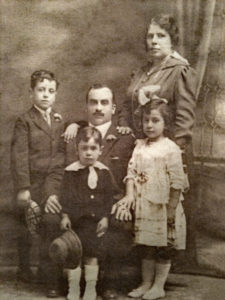
Circa 1920s: Marco Tarica & Rachel Touriel and children: Samuel, Morris and Esther. From: Robert Carlson.
Religious services were held primarily at the home of Marco Tarica, at 606 Crocker Street, where the Torahs were kept, although members also conducted prayer services at their individual homes. For High Holiday services, the Peace and Progress Society would rent locations in order to accommodate all of its members simultaneously. The first locations rented were the Burbank Theater on Main Street (between 5th and 6th Streets), and at the Moose Lodge (at 3rd and Main Streets). The first reader (or hazan) of the organization was Reuben Israel, who was a shoemaker.
Assistance for the needy members of the community was carried out through the creation of “el fundo secreto” (the confidential fund). Certain selected members of the board of directors would be in charge of a discretionary fund to aid financially those people who were in need. It was a tradition which was utilized in Rhodes and continues in Los Angeles.
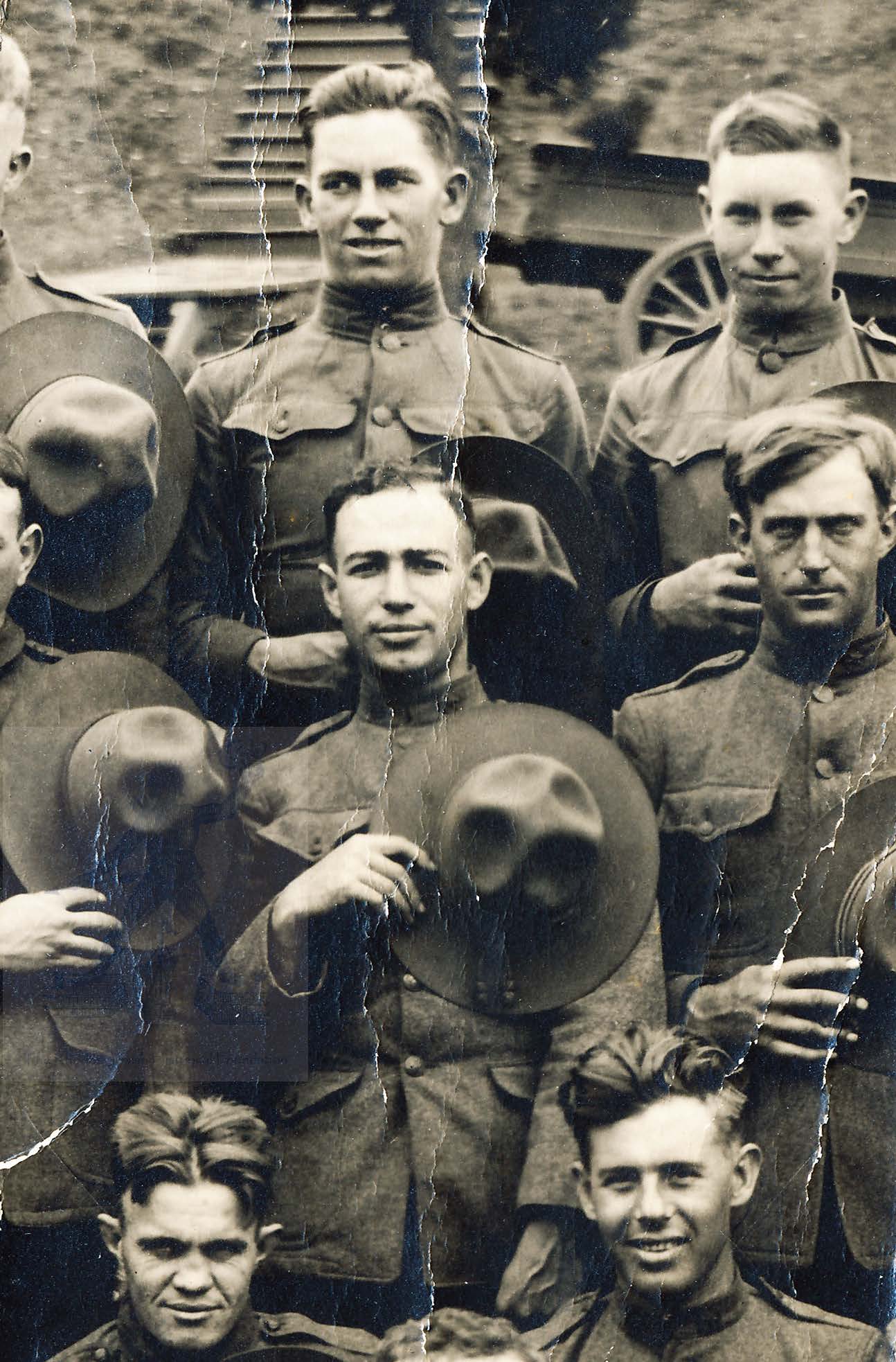
Center: Joseph Behor Hasson US Army Battalion during WWI.
The Peace and Progress Society was founded during World War I, and as a consequence, the war had an effect on the future of the Los Angeles Rhodesli community. Even though a large number of these young immigrant men were Turkish citizens, and classifiable as enemy aliens, a handful of them claimed exemption from that status and voluntarily joined the United States Army.[10] These young men included Jack Alhadeff, Behor Capelouto, Leon Hanan, Joseph Hasson, Yousef Israel, Victor Levy and Ray Soriano. This military service consequently became a significant step in further establishing the Sephardic community in Los Angeles, since as veterans of the war, they were immediately entitled to U.S. Citizenship.[11] This in turn gave them status which later allowed them to petition for other relatives to immigrate to the U.S. after the immigration quota restrictions began in 1922. In addition, it gave them a respected stature in the non-Sephardic community as contributors to the welfare of the United States.
In 1919, when World War I ended, a new wave of Rhodeslis came to this country. This time it included many young women who would marry the many available bachelors. Many of the young women came for “arranged” marriages previously planned for them by their families in Rhodes. As the number of Rhodeslis in Los Angeles continued to increase during these years, it became advantageous and necessary for the synagogue to obtain a permanent location.
The Peace and Progress Society took an important step in 1921 by purchasing the old B’nai B’rith Lodge at 17th and Georgia Streets. The negotiators of the purchase were Jack Notrica, Victor M. Levy, Joseph Mayo and Edward Almaleh, and the sale price was $13,000. The person representing the sale of the B’nai B’rith Lodge was L.A. Rose. This early Sephardic relationship with the Ashkenazim was typical of the future amicable interactions among the two groups. As Edward Almaleh recalled: “I offered $13,000 including all the furnishings. I had barely made the offer before Mr. Rose stood up and accepted it, with the condition that they could use the hall for meetings until their building located at West 8th Street and Valencia was completed. The two organizations were very compatible.”[12]
The most successful occupation with many of the young Rhodeslis in Los Angeles was selling flowers. In addition to sales on downtown street corners, the young men would fill a large basket with flowers and then ride the streetcars to different locations, attempting to sell off their entire load. Many of these flower peddlers became prosperous enough by the early 1920s to set up small flower shops or stands. These businesses have been continued by many Rhodesli families, often being passed down from parents to children.
Another important occupation for the Rhodeslis was selling produce. By 1925 there were as many Rhodeslis in the produce business as there were in the florist trade. Initially, makeshift fruit stands were set up in neighborhoods, while later small to large grocery stores were established by them. However, since the emergence of supermarkets, many of the Rhodesli produce stands and grocery stores were phased out.[13] These produce businesses, like the flower shops, became occupations established by fathers and usually handed down to their children.[14]
Even though the Rhodesli immigrants who pioneered Los Angeles had only a basic education they were determined to succeed financially. They worked long hours to help their families who remained on the Island, as well as to better themselves in their newly adopted home in the United States. Since they spoke little or no English the pioneer immigrants attended night school, realizing that in order to prosper they would have to learn the language.[15] In the Sephardic homes the children were directed to speak English instead of Ladino so they would have a better chance to improve themselves educationally, socially as well as in the business world. This goal was accomplished since the second and third generation of the Rhodeslis have become successful in all of the professions as well as in the business community.
ESTABLISHING A NEW “JUDERIA” IN LOS ANGELES
As conditions changed in the downtown area, and the economic condition of the Sephardim improved, they moved to a newer neighborhood five miles to the southwest. The transfer began about 1920 and soon the community was living between Vernon Avenue and 56th Street, and between Normandie Avenue and Broadway (the South Central Los Angeles area). During the 1920s, as noted, many marriages took place among the young Rhodeslis who were intent on making Los Angeles their new home. The Island of Rhodes was now being thought of by the immigrants as the home of their parents, and not for themselves. By the 1930s there were about three hundred families re-established from Rhodes in Los Angeles. For example, the Talmud Torah (the religious school of the Peace and Progress Society), in 1934 had 65 children, all born in Los Angeles.
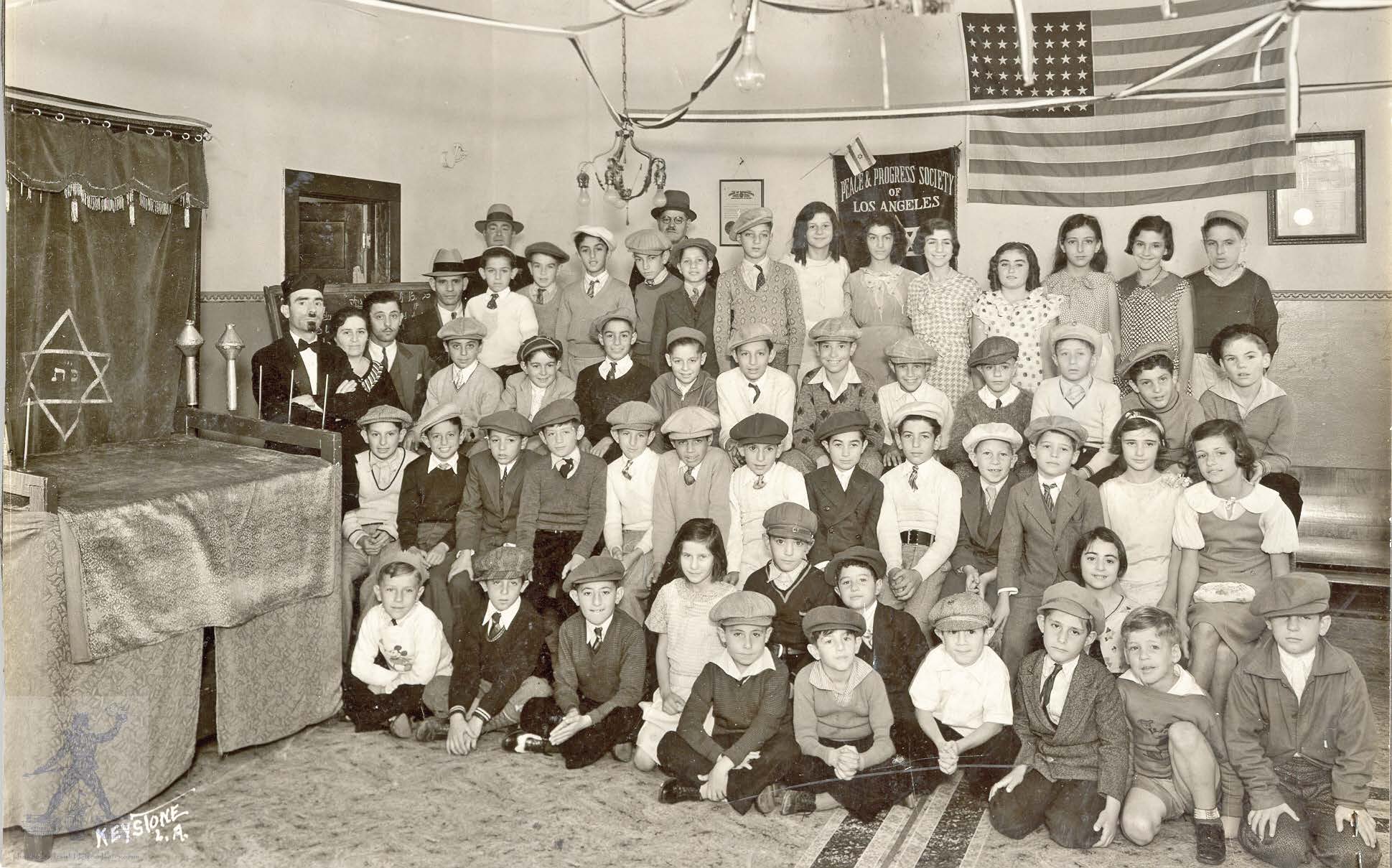
1933 Los Angeles Rhodesli Talmud Torah of “Sociedad Paz i Progreso”
Front row (L-R): Morris Cohen, Aaron Cohen, Bob Cohen, Kaye Hasson Israel, Ray Codron, Ralph Mizrahi, Edward Mizrahi, Jack Hasson, Joe Mizrahi, Victor Levy, Sarah Mizrahi, Sam Benoun and Jack Cohen. 2nd Row: Edward Capelouto, David Solam, Vic Israel, Chic Benveniste, Nathan Cordova, Ray Varon, David Alhadeff, Ted Hasson, Sam Cordova, Vic Benatar, Jack Benoun, Mary Scapa and Rachel Benveniste Feldman. 3rd row: Kenny Cohen, Dave Mizrahi, Leon L. Benveniste, Vic Randel, Bob Varon, Sam Israel, Solly Israel, Vic Nathan, Bill Comerchero, Meyer Huniu and Rafie Cohen. 4th row: Marco Cohen, Joe Israel, Marco Berro, Morris Israel, Bob Angel, Albert Benveniste, Rachel Hasson Senzell, Rachel Benveniste, Phylis Benveniste, Rita Berro Gross, Rachel Cordova, Becky Benoun Fiss and Victor Cohen. The six adults at the left: Rabbi Solomon Mizrahi, Regina Mizrahi, Harry Capelouto, Sabetai Benoun, Yakir Hasson and Jacob Hasson (the “shamash”).
For the convenience of religious and social gatherings, the Sephardim found it helpful to reside near one another, and thus created a “Juderia” in Los Angeles, as a Sephardic Jewish neighborhood. This is evidenced by noting the two most densely populated blocks in the 1920s and 1930s. On 51st Street (between Hoover and Figueroa), resided twenty Sephardic families, and on 50th Place (between Hoover and Vermont), resided eighteen.
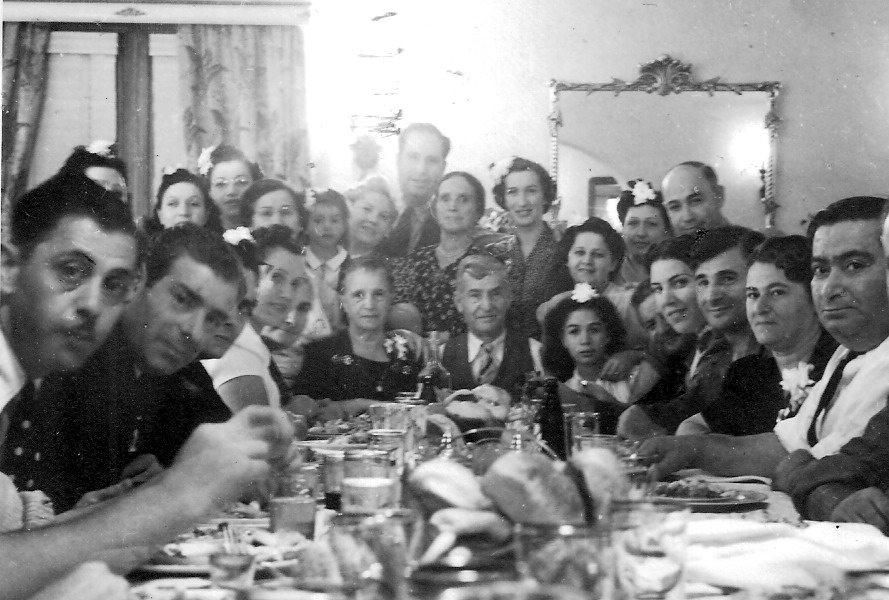
Rhodeslis at a home gathering: Capilouto, Berro, Mizrahi, Levy, Hasson, Benveniste and Piha families. From: Jennifer Goodman.
It thus became apparent that the Rhodesli community should build a temple or center, of its own, in order to centralize all of its social and religious activities. A location was found at 55th and Hoover Streets which resulted in the groundbreaking for the new synagogue which took place on October 21, 1934. The president of the temple was Peter Alhadeff, and the vice-president and chairman of the building and finance committee was Joseph Hasson.
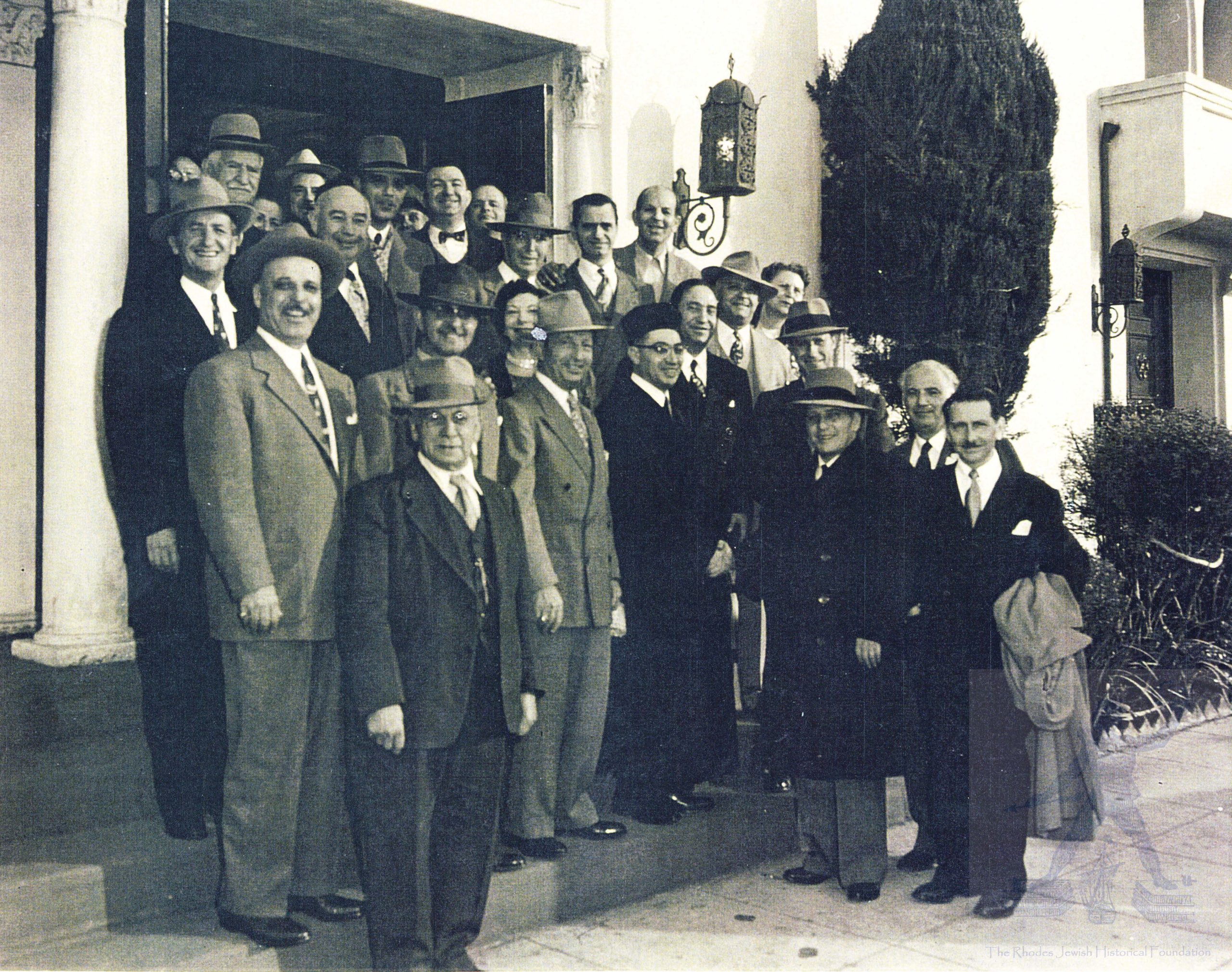
Rhodeslis at 55th and Hoover.
Along with the new temple building came a new name for the synagogue organization. It was changed from the Peace and Progress Society, to the Sephardic Hebrew Center. The new name would correctly identify the community for its Sephardic background.[16]
The synagogue was built during the Depression; it cost $26,000 to purchase the land and to pay for the construction. Three adjacent properties were acquired at the corner of 55th and Hoover: a small store on the corner, an empty lot and a small house. It was built by the Zimmer Construction Company[17]. The architect was Edith Northman. The sanctuary seated 550 persons, including a balcony (Ezrat Nashim) used for seating the women. The auditorium and dining room seated 400. The building gave great pride to the Sephardic community. It was the center of the religious and social life for the Rhodeslis for about twenty years. The highly respected spiritual leader and educator was Rabbi Solomon Mizrahi, who served from 1930 to 1947.
The synagogue also published a monthly newsletter during the 1930’s called “El Messajero.” The newsletter was published mostly in Ladino, using Hebrew and Latin characters, while some articles were written in English, to inform it’s multilingual members of social events and other news of interest. “El Messajero” was named after a similar publication printed in Rhodes during the Italian occupation.
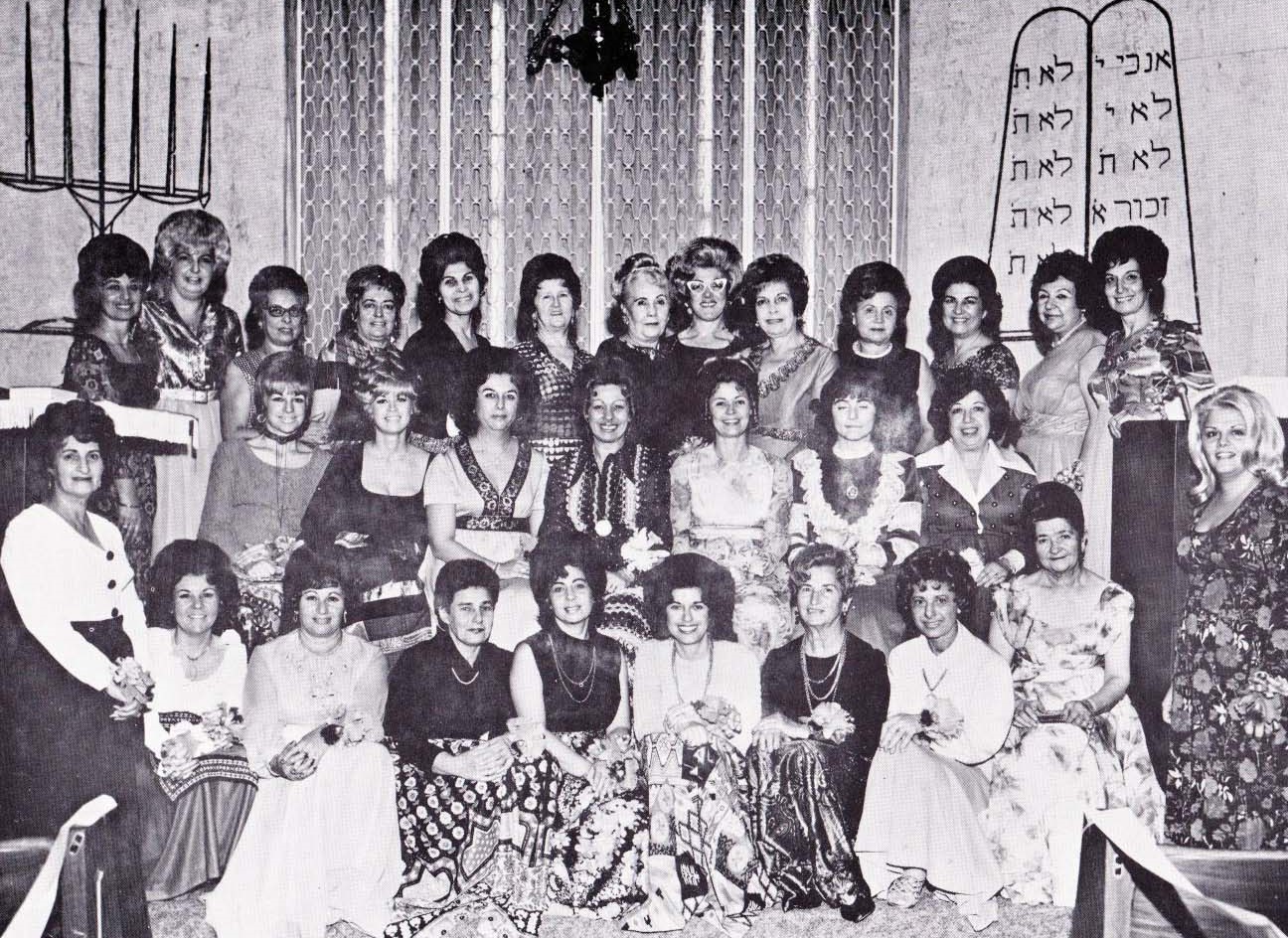
Board of Directors – Ladies Auxiliary 1972
The ladies auxiliary, which was established to promote the activities of the organization, became even more active in supporting the synagogue’s events. The women undertook and assisted with major fund raising events. Their skills and hard work in preparing the traditional Sephardic foods made the events and social affairs very successful. The Rhodesli women also contributed to the community by binding the families with social and moral values. It is important not to see the women as simply assisting the men, because they were leaders in their own right, and in many cases it was the men who assisted them![18]
THE SYNAGOGUE IN LADERA HEIGHTS
During the 1950s the synagogue membership was dispersed into other neighborhoods of Los Angeles. This movement was primarily westward into the newer suburbs. With this new shift in demographics, the temple at 55th and Hoover began losing its importance as the neighborhood synagogue of the Los Angeles “Juderia”. With great reluctance it was agreed that the synagogue location must be moved. It had been the locale formation and the locus of many events sentimentally remembered.
The 55th and Hoover synagogue was sold in 1958 to an African-American church organization[19], and the Sephardic Hebrew Center began using the Maccabean Sephardic Center at 5969 Crenshaw Blvd., for most of its activities.[20] For High Holiday services, the synagogue rented the Youth Center at Crenshaw and Santa Barbara (Martin Luther King) Boulevards.
It was finally agreed by the members of the temple to go forward with creating a new temple. A lot was purchased at 59th Street and Fairfax Avenue in Ladera Heights. In September 1966, in time for the high holiday services, the temple was newly completed. The president of the congregation was Ted Hasson, and Edward Mizrahi was chairman of the building committee. This synagogue served the Rhodesli community for twenty seven years.
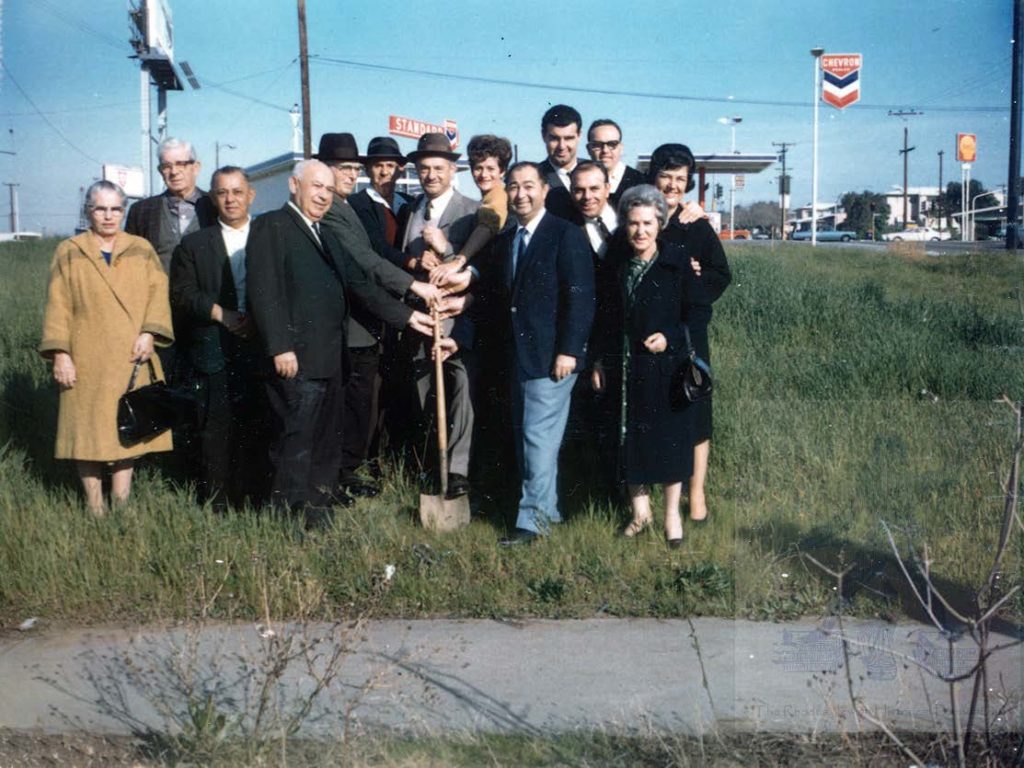
Ladera Heights Temple Groundbreaking Ceremony
Another monthly newsletter started during the 1960’s was the Sephardic Star of the Sephardic Hebrew Center, edited by Jack Israel. In 1987, a previous member of the women’s board of directors, Rebecca Levy, published a very successful book called “I Remember Rhodes”.
The Sephardic Hebrew Center honored special individuals by presenting them with the “Man and Woman of the Year” award. Those recipients were: Joseph Hasson, Joseph Mayo, Dr. Irving Benveniste, Ted Hasson, Lou Angel, Jake Agoado, Morris Mizrahi, the Benon Brothers (Morrie, Leon, Sam and Joe), Robert Cohen, Lou Hasson, David Peha, Morris Y. Angel, Nace Surmani, Jack Israel, Tillie Scapa, and Albert Collins.
From the time the first Rhodeslis came in Los Angeles to the present, there has always been a blending of families as well as social affairs with other Ladino speaking Sephardim. Many social and religious activities were organized among the two main groups (the Rhodeslis and what is now the Sephardic Temple Tifereth Israel). There has also existed other organizations which combined all of the Ladino speaking Sephardim, such as The Macabbeans, which conducted a talmud torah and served as a social club, the Los Angeles Sephardic Home for the Aging (L.A.S.H.A.)[21] which established a home for the elderly members of the community in association with the L.A. Jewish Home for the Aging, the Sephardic Educational Center, and the Sephardic Hebrew Academy, which are teaching institutions.
THE REUNIFICATION OF THE LADINO SPEAKING SEPHARDIC COMMUNITIES
On August 1, 1993 the Rhodesli synagogue and the Sephardic Temple Tifereth Israel voted to merge together into a greater Ladino speaking Sephardic congregation. The new entity, with an enhanced spiritual center of 1,000 members, took on the name and location of the larger partner, the Sephardic Temple Tifereth Israel, in Westwood.[22] Readers will remember that both communities were originally part of the same synagogue, the Sociedad Ahavat Shalom, from 1912 to 1917.
In a large Sephardic ceremony held on December 5, 1993, the six torah scrolls from the Sephardic Beth Shalom were led in a procession around the outside of the Sephardic Temple Tifereth Israel, and then led into the main entrance, where they were greeted by a sepher torah held by the president of Sephardic Temple Tifereth Israel, the universally respected, Ralph A. Amado. The scrolls were then carried into the sanctuary where they made seven circuits around the bema (tevah), before being placed in the ehal (aron ha kodesh). President Amado made a gracious welcome statement followed by a warm reply by Rae Cohen, President of the Sephardic Beth Shalom.
This reunification between the two oldest and largest Ladino speaking Sehardic synagogues in Los Angeles helps perpetuate the special traditions of this unique Jewish community, as a major constituent of Jewish life.
THE CATALINA STORY
There is a Rhodesli custom that independently survives the reunification of the Sephardic Beth Shalom with the Sephardic Temple Tifereth Israel. It is one of charm and as often happens, it is a charm which flows from nostalgia.
Ever since those young men from Rhodes established themselves in Los Angeles, they were attracted to another island for their vacations near Los Angeles, called Santa Catalina. From the beginning it has been a favorite annual vacation spot for the immigrant families.
Catalina, and its primary town of Avalon, is situated 25 miles across from the Southern California coastline and is coincidentally similar to Rhodes’ distance from the Turkish mainland. Louie Benveniste first vacationed in Catalina in 1918, with his wife, Behora, and son Bob, who was one year old at that time. The boat trip cost $2 round trip in that year, and the house they rented cost $7 for one week. Louie Israel visited Catalina in 1920 with a few other friends, and stayed in the villa area, which had tents, instead of homes and motels as it is today. He explained his enjoyment of Catalina by saying, “once you are born on an island with the water all around you, you just like the ocean. The water attracts us.”
Every year in August, many Rhodeslis still take a week holiday in Avalon. The traditional Sephardic foods are served at parties in the beach town. There are so many members of the synagogue there during that week in summer that a person could not walk down the Avalon boardwalk without seeing someone they know.[23]
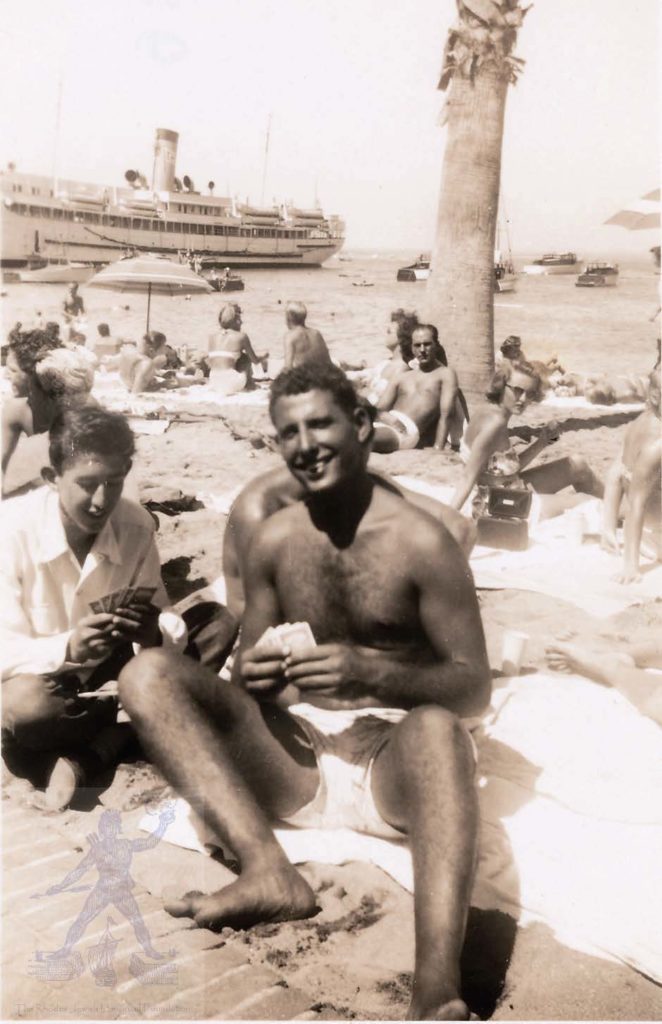
1940s. Joe Benon and Vic Levy at Avalon Beach, Catalina Island.
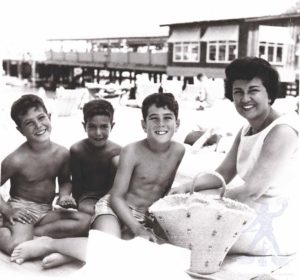
Pearle Benoun Hasson and children near the pier, Catalina Island.
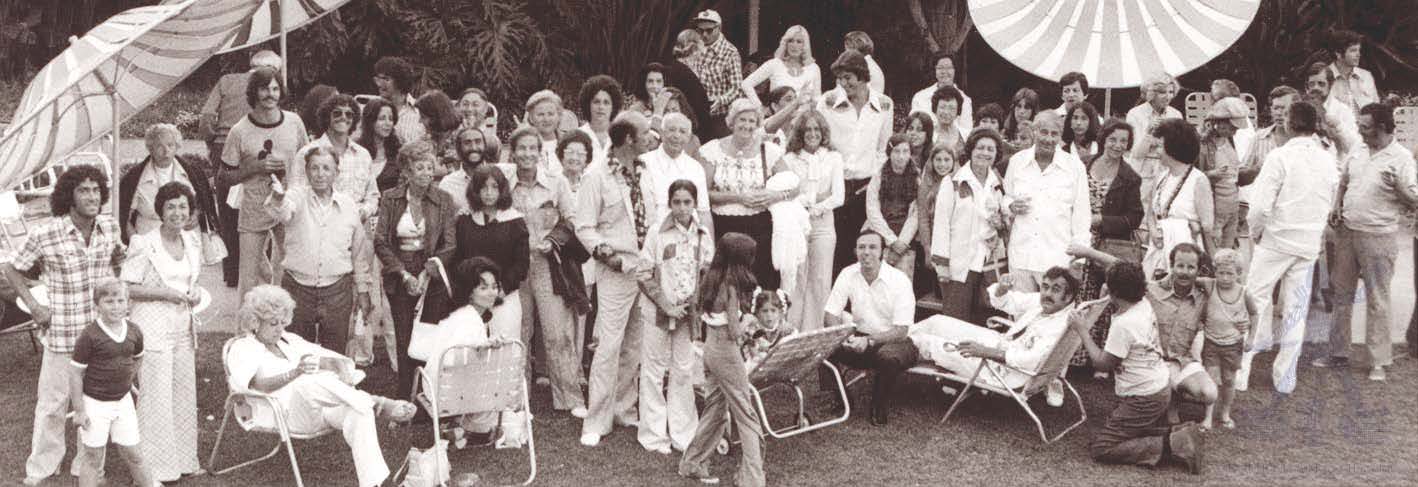
1970s. LA Rhodeslis at the Pavilion, Catalina Island.
[1] Rhodes is a Greek island (Turkish from 1522 to 1912, Italian from 1912 to 1946), situated ten miles from the southwestern mainland of Turkey. The Jewish community was located in the largest city of the island, also called Rhodes.
[2]A smaller number of young men left the Island in order to avoid the Turkish army.
[3] Constitution of the “Sociedad Ahavat Shalom”, incorporated with the state of California on January 17, 1914.
[4]The largest group consisted of the Rhodeslis, who left the group in 1916. In 1919, the remainder of the “Sociedad Ahavat Shalom” dissolved and divided itself into three groups. These were the Sephardic Communidad, the Haim Vahessed and the Yacov Tovi. Within two years the small Yacov Tovi group disbanded and it’s members joined either the Haim Vahessed or the Sephardic Communidad. In 1959 the Haim Vahessed (also known as the Sephardic Brotherhood), combined with the Sephardic Communidad (which later changed its name to the Sephardic Temple Tifereth Israel).
[5] It later changed it’s name to the Sephardic Hebrew Center (in 1934) and the Sephardic Beth Shalom (in 1990).
[6] Constitution of the “Sociedad Pas y Progresso,” dated May 31, 1917.
[7] This small Sephardic restaurant was owned by Israel Hanan and Isaac Solam. The following year it moved two blocks away to 214 Winston Street, under the ownership of Israel Hanan and Yacov Levy.
[8]The term “Turkish origin” was used amongst Sephardim as a generic term which included Rhodeslis and other Sephardim.
[9] Articles of Incorporation of the Peace and Progress Society, incorporated with the State of California, dated May 18, 1917.
[10] Joseph Hasson, Los Angeles, Interview, March 13, 1972.
[11]Immigration and Nationality Act, Section 329, 8 USC Section 1440.
[12] B’nai B’rith Messenger, June 1981, by Edward Almaleh in “Letters to Editor”.
[13] The only one remaining is 32nd Street Market, owned by Morris Notrica and previously called “Morrie’s”. He continued in the grocery business which his father, Joseph, was also in.
[14]For an occupational analysis of the Rhodeslis, see the “Rhodeslis Listed in the Los Angeles City Directories” in this volume.
[15]An exception to this was the close relationship of Ladino to Spanish, which actually served as an advantage in communicating with the growing Latino community.
[16] Sephardic Hebrew Center Souvenir Dedication Program (Los Angeles, March 17, 1935).
[17]Max Zimmer was a contractor for many Jewish community buildings. His life has been told by our editor, William M. Kramer, in his book entitled, The Century of Max Zimmer; Western States Jewish History, 1993.
[18]The first woman president of the synagogue, Rae Cohen, served from 1992 to 1993.
[19]It was sold to the Second African Methodist Episcopal Church (aka Second AME).
[20]The Maccabean Sephardic Center served the entire Sephardic community at that time for a talmud torah, youth center, social hall, as well as for conducting religious services.
[21]Founded in 1953, in Los Angeles, it’s first President was Joseph Arouh.
[22] The Sephardic Temple Tifereth Israel is comprised primarily of Ladino speaking Jews of other Aegean Sea communities, such as Istanbul, Izmir, Salonica, Brusa and Rhodes. This synagogue was established in Los Angeles on March 22, 1920, and is presently located on 10500 Wilshire Boulevard in the Westwood section of Los Angeles.
[23]The following people were interviewed for information regarding the history in this article: Peter Alhadeff (10-19-82); Esther Altabet (Tarica) (7-21-82); Jack Avzaradel (11-18-74); Sepora Benon (Amato) (2-27-72); Jean Bensusen (Almeleh) (7-25-82); Irving Benveniste (1-30-83); Louie Benveniste (7-18-82); Behor Capelouto (4-19-72); Joe Capelouto (4-26-72); Aron Cohen (11-5-74); Lena Cohen (7-11-82); Jean Conae (Israel) (7-29-82); Catherine Elias (Caraco) (10-22-74); Eli & Reina (Hazan) Israel (10-15-74); Louie Israel (4-18-82); Gladys Rubin & Ann Cordova (Mayo) (8-3-82); Morris Mizrahi (1-2-73); Gracia Hasson (7-26-82); Joseph Hasson (3-13-72); Albert & Amelie (Berro) Notrica (6-22-74); Francis Elmgreen (Soriano) (7-11-82).
References:
Hasson, A. (1996). The Los Angeles Rhodesli Sephardic Community. Sephardic Jews in the West Coast States, 383-395. The Los Angeles Rhodesli Sephardic Community by Aron Hasson 1996
Hasson, A. (1974). The Sephardic Jews of Rhodes in Los Angeles. Western States Jewish Historical Quarterly, 241-254. The Sephardic Jews of Rhodes in Los Angeles by Aron Hasson 1974
Hasson, A. (2016). A Century of the Rhodeslis in Los Angeles. The Rhodes Jewish Historical Foundation.

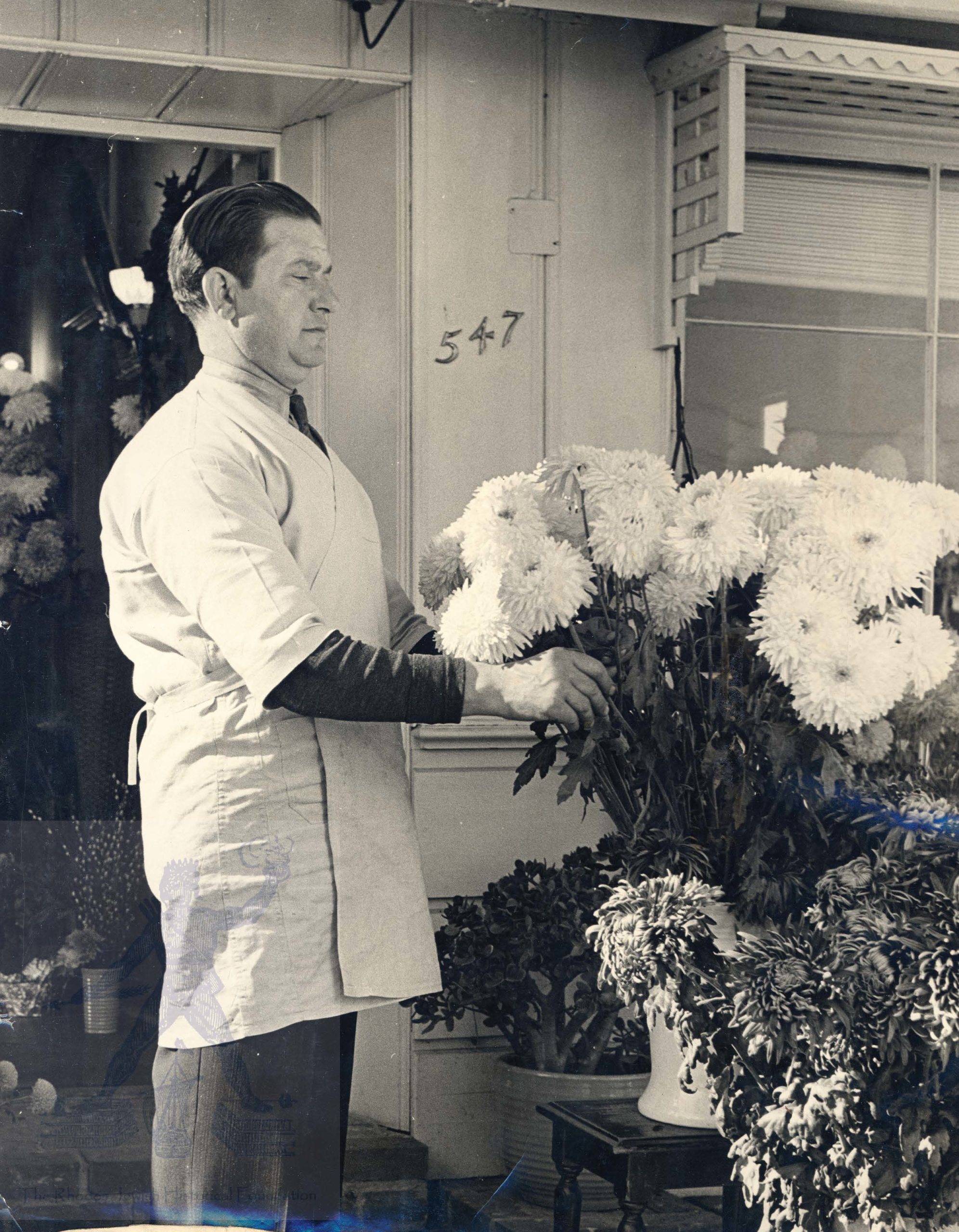
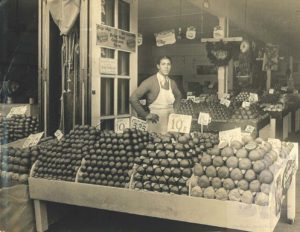
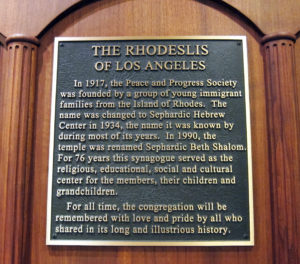
While we recognize the Los Angeles “Out to Lunch Bunch” as a tradition of men gathering, women in our community are welcome to join. So, let’s cultivate friendship through our shared heritage and learn a thing or two from one another. Please spread the word and invite the Hermanos & Primos of all generations. Seating is limited, so paid reservations are a must. See you on Feb 28th!
Love seeing all the names. Thank you Aron.
Great story. Haim Mayo also joined the service in 1917
Great story. Haim Mayo also joined the service in 1917. My great uncle Joe Mayo was one of the pioneers of the 55th and Hoover synagogue. My mother Rebecca (Mayo) Cohen married Alfred Cohen. He will be 100 years old in 2 months. Anyone others still around from that era?
Sheldon Cohen
What a wonderful time reading this information about our history! I found my mom listed (Frances Soriano Elmgreen)!!! My grandfather (Morris Soriano, the first congregation president as I recall) who is listed as well!!!! I recognize about 4-5 names from family and social gatherings when I was younger. This is so great!!!! I already told my kids and husband. My cheeks are aching from smiling so hard. Thank you so much!!!
I am thrilled that I found this site. have been searching for years for some history of the Hasson family. My Father was Morris Hasson brother of Isaac Hasson of Portland, Oregon who organize the Sephardic group there. I was born in 1927. My Father was in the flower business but later opened a shine stand or shoe repair shop. I’m related to the Mayo Family who had a Flower Shop in the Atlantic Blvd. Area.
I was born in L.A. on 1956. My dad was from Rhodes left at 13 to Auschwitz. Any of us left?
My late Aunt Flora (Tarica y Avzaradel)born in Rhodes in 1903 moved to the USA (N.Y., later L.A.) always said “Catalina Island looks so much like Rhodes…
Thanks for this great article
EXCELLENT! THANK YOU!!!!!
Thank you very much Aron for your great article and passion for the Sephardic community and our heritage/history.
This is a wonderful telling of our local history. Ties together all of the stories heard from my parents and their friends that I wish I had paid better attention to growing up.
My stepfather Leon Berro was one of those young men that came to this country in 1910’s20’s. His brothers went to South America where sephardic comunities flourished, especially in Montevideo, Uruguay. Very nostalic to read this historical overview. Thank you.
Thank you so much for such an informative presentation it brought many memories of my parents talking about Rhodes and how much they loved their roots.
A truly wonderful website –fills in so many gaps in the history of my parents who were both from Rhodes (Diana Hazan and Jack Bardavid). Thank you for all your work. Maurice Bardavid
Dear Selma Jaffe, i think we are family. I’m from Buenos Aires. You are the sister of Jack Franco from Brazil? My grandparents are Celma Franco and Yaco Saal. Please keep in touch, best regards. Shana Tová! Daniel
Thank you all, especially Aron for creating this amazing historical website for us to enjoy. This great piece of Sepharic history and tradition will be something special for all the generations to come. Thank you again, warm wishes always, Selma & John Jaffe, Renee, Denise & Michelle
Many thanks for a wonderful web site.
wonderful reading. well put together, documented, and extremely interesting. Would love to see someone do this for the Portland, NYC, and Atlanta communities as well. Thank you for all the hard work.